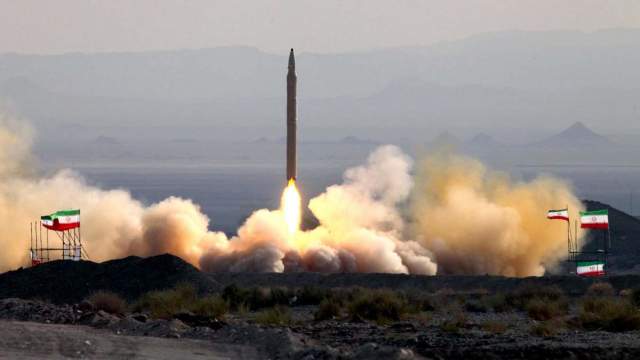We continue the topic of ballistic missiles (BR) of the Islamic Republic of Iran. Having briefly reviewed the history of the formation of the Iranian missile strategy ( Part I ) and the composition of the missile sector in the defense industry complex of Iran ( Part II ), let's move on to the BR on liquid fuel.
Iran's liquid-fueled ballistic missiles
The roots of IRI's work in the field of BR technology date back to the period of Shah Reza Pahlavi. In April 1977, as part of the Flower Project, Iran concluded a total of six agreements with Israel on the acquisition of missile technology and weapons in exchange for oil supplies. It was planned that as a result, a missile testing ground would appear in the south of the country. After the victory of the Islamic Revolution in 1979, this project was curtailed.
In 1985, out of 8 Scud missiles received from Libya, at the insistence of Hassan Tehrani, two missiles were handed over to Iranian engineers for the manufacture of similar samples by reverse engineering. Two years later, in 1987, Iran signed an agreement with the DPRK on missile technologies. According to the agreement, the country received several hundred Hwasong-5 tactical missiles (OTR) (the Korean version of the Russian R-17 missile, also known as Scud-B), and after the end of the Iran-Iraq conflict, the Hwasong-6 OTR (a derivative of Scud-C). Iran has started its own production of these missiles under the names "Shehab-1" (Shahab-1) and "Shehab-2"
“Shehab-1” and “Shehab-2“
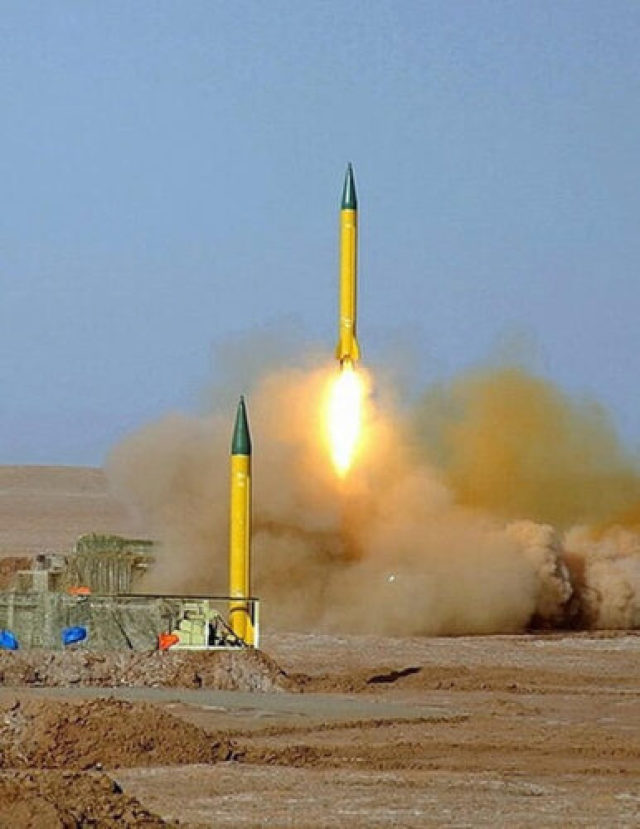
Shehab-1 ballistic missileAccording to the International Institute for Strategic Studies (IISS, London), the Shehab-1 is practically a copy of the Scud-B missile.
There are some minor modifications in its design that allow the use of components that are more easily acquired or manufactured by North Korea or Iran. Thanks to the steel body, the Shehab-1 is durable and can be transported with refueled fuel. The warhead of the missile has a mass of 1000 kg and can be delivered to a range of about 300 km. At the same time, "Shehab-1" is not perfect, in terms of accuracy. The very outdated navigation and guidance systems of the rocket give a circular probable deviation (CVO) exceeding 700 m.
The Shehab-2 is a modified Shehab–1 rocket using the same combination of engine, fuel, oxidizer and probably a similar guidance and control system. The external dimensions of the two missiles are the same, although the Shehab-2 carries 200 kg more fuel and oxidizer. The mass of its warhead is 730 kg. A lighter warhead and additional fuel allowed to increase the firing range to 500 km, which allows Iran to reach targets in the coastal zone of the Persian Gulf. However, when using the same components, the missile's CVO is more than 1500 m, which makes it insignificant militarily in the case of equipping the warhead with a conventional explosive (BB). Nevertheless, Shehab-2 poses a threat to large urban centers, just as Iraq did in 1991 during the First Gulf War.
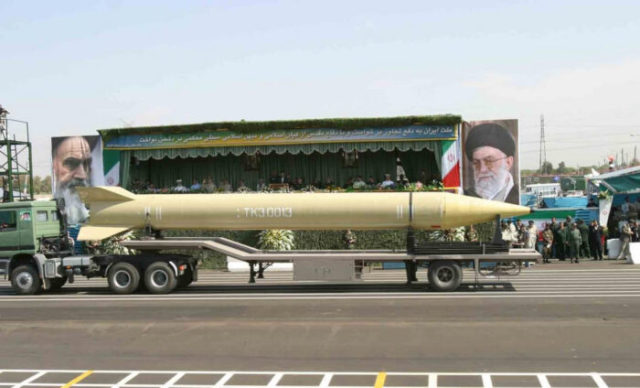
Iran's Shehab-2 ballistic missile According to various sources, the assembly of the Shehab-2 began in 1994, and by 1997 Iran finally organized reliable production of this missile.
At the same time, Tehran continued to rely on foreign sources (primarily North Korea) for key components such as liquid engines, high-speed turbopumps, gyroscopes and electronics.
"Shehab-3"
In order to meet the need for a more powerful missile capable of reaching Israel from the depths of Iranian territory, Iran purchased the No-Dong system from the DPRK and renamed it Shehab–3. Depending on the mass of the warhead (760-1000 kg), this single-stage missile has a firing range from 800 to 1000 km. The Shehab-3 is equipped with a single-chamber liquid engine of unknown origin with a thrust of 27 tons. The engine uses an AK-27 oxidizer (a form of inhibited nitric acid) and a hydrocarbon fuel known as TM-185. According to IISS experts, the same combination of rocket fuel was used in several early Soviet missiles, including the R-12 Dvina (SS-4) and R-17 (ScudB).
The body and fuel tanks of the Shehab-3 are made of steel, which makes the rocket quite heavy and inefficient by modern standards. The missile can carry a chemical or biological warhead, but for this, Iranian engineers need to develop methods to protect agents from overheating during flight. The Shehab-3 has a nose diameter of 720 mm and is capable of delivering about 1,000 kg of payload, which makes it possible to carry a first-generation nuclear warhead similar to the one whose drawings Abdul Qadir Khan sold to Libya in 2001-02. It is claimed that in the early 2000s, Tehran really studied the development of a nuclear warhead for the Shehab-3.
Shehab-3 uses an inertial guidance unit of unknown origin. Presumably, it is similar to a crude but moderately efficient system installed on Scud-B. If such a system is really used, then the accuracy of the Shaahab-3 at the maximum range is limited to the CVO within 2500 m.
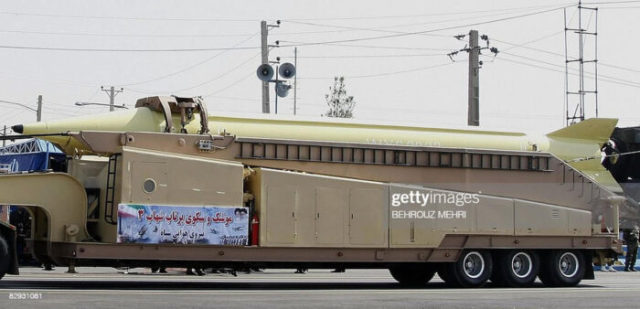
Iran's Shehab-3 ballistic missile Although during recent military parades, observers noted several variants of a transport launcher (TPU), it is assumed that the Shehab-3 is launched from a towed TPU based on a tractor with a Mercedes trailer.
The TPU itself, as well as the auxiliary machines deployed with it, are apparently Iranian modifications of commercially available equipment.
After the Shehab-3 was announced for service in mid-2003, Iranian engineers tried to increase the firing range of the missile. Since the modification of the standard engine would have given only limited success, in order to achieve more significant results, work was carried out in several directions: the search for a more powerful engine, a major upgrade of the hull design in order to reduce the mass of the rocket and the addition of fuel to increase the engine's operating time. The first would be difficult at best, since there are few such engine options on the international market. Consequently, the only viable approach available to Iran to increase the firing range was a serious reconstruction of the Shehab-3 hull and payload.
Since 2004, Shehab-3 has undergone several significant but evolutionary changes. Some of them were clearly visible, including changes in the geometry of the warhead section, a reduction in the size of the aerodynamic stabilizers in the aft part of the rocket and the lengthening of the hull and tanks to accommodate additional fuel. Less obvious innovations were the use of aluminum alloys instead of steel, a reduction in the mass of the warhead, the rearrangement of oxidizer tanks, fuel and pressure cylinders inside the rocket body, as well as the installation of new navigation and guidance systems. Together, these engineering solutions led to the creation of a new Gadr-1 rocket.
"Ghadr-1" (Ghadr-1)
The Gadr-1 is an improved version of the Shehab–3, which Tehran first introduced in 2007. The total length of the rocket is 16.6 m, which is about one meter more than its predecessor. The diameter of the case remained unchanged – 1.25 m. The increased length was used to accommodate stretched fuel tanks and oxidizer tanks, which additionally hold from 1300 to 1500 kg of fuel. The added fuel allows the engine to run for about 10 additional seconds. However, the added propellant load also increases the take-off mass of the rocket.
To compensate for the added mass of fuel, the Gadr-1 body is made using lighter aluminum alloy components, which reduces the inert mass by about 600 kg compared to the all-steel version of the rocket. This ability to produce aluminum hulls is considered a major achievement of the Iranian missile industry.
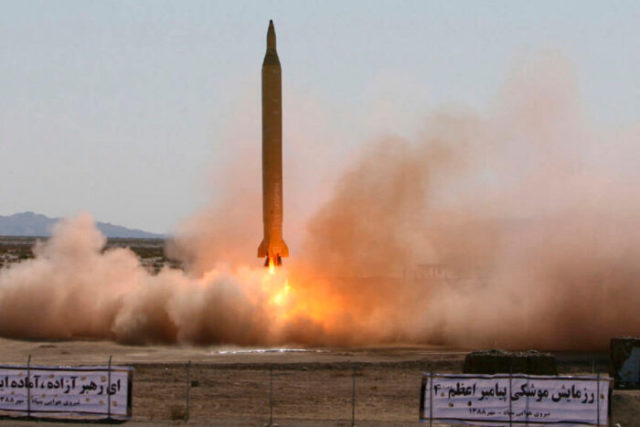
Iran's Gadr-1 ballistic missile The mass of the Gadr-1 warhead has also been reduced from 1000 kg to about 750 kg.
The reduction of the total inert mass (including warhead) from incomplete 3 to about 2 tons, combined with an additional propellant load, increased the practical firing range of the missile to 1600 km.
The design of the "Gadr-1" also changed the shape of the warhead. The new head compartment has a conical nose, followed by a short cylindrical part (the shape of a "baby bottle") and an expanding skirt at the bottom, where the compartment joins the main body of the rocket. The base of the conical bow and the short cylindrical part have a diameter of 60 to 65 cm compared to 72 cm in the "Shehab-3". Compared to the Shehab-3, the modified geometry reduces the total volume and mass of the warhead by about 20%.
The average density of the Gadr-1 warhead is slightly increased, which, combined with an improved aerodynamic shape, leads to a higher rate of re-entry into the atmosphere. Depending on the flight range and the total mass of the warhead, its attack speed can be two to three times higher than that of the Shehab-3. Higher attack speeds leave a shorter time for the reaction of the means of intercepting the enemy's missile defense. At the same time, the new head unit also offers better accuracy than the Shehab-3. In combination with the use of a more modern free-form inertial guidance system, the QVO Gadr-1 can be limited to 300 m.
With the help of the Gadr-1, Iran can strike at Israel from the depths of its own territory. Nevertheless, Western experts believe that the project is associated with technical risks and is expensive. Modifications required serious engineering efforts, taking into account changes in the center of pressure and the center of gravity of the new rocket, new aerodynamic forces and structural dynamics. In addition, to ensure success, it was necessary to combine extensive engineering calculations, computer modeling and experimental data in a wind tunnel on scaled models. However, most importantly, during the redesign, Iranian engineers and project managers were able to develop and apply a comprehensive, rigorous system design and management process.
"Kiam-1" (Qiam-1)
"Kiam-1" is a short–range mobile ballistic missile (BRMD) on liquid fuel. It was first tested in 2010 and is a variant of the Shehab-2 with several upgrades. The most noticeable difference from the prototype, which represents a major technological breakthrough, is the lack of external stabilizers in the rocket. This design feature indicates that the Kiam-1 has an improved thrust vector control system to stabilize the rocket at the acceleration stage. Removing the stabilizers also slightly reduces weight and resistance. These changes, along with the transition to an aluminum body and a smaller payload, allowed to increase the firing range to 800 km.
Kiam-1 can also rely on a ground-based radar that guides the rocket during the acceleration stage, as well as on a detachable warhead, the shape of which increases flight stability after separation. It is obvious that the combination of ground guidance and a detachable warhead will make it difficult for missile defense to counteract. At the same time, experts believe that the design of the head unit does not equate the warhead of the missile to the MaRV type (maneuvering detachable warhead), and the Kiam-1 QUO still exceeds 1000 m.
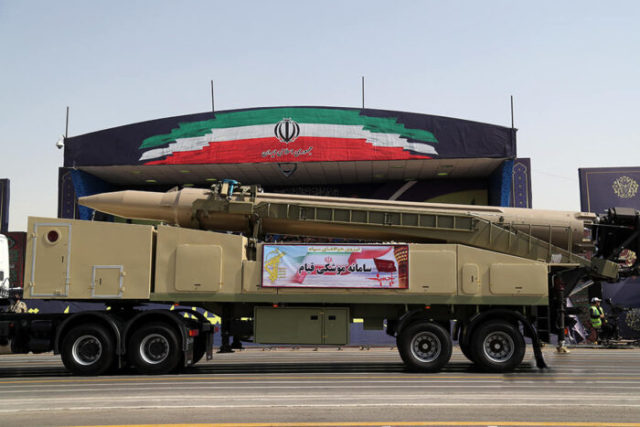
Kiam-1 ballistic missile on parade in Tehran The first known operational use of the Kiam-1 was noted on June 18, 2017, when Iran fired a volley of missiles at IG targets (banned in the Russian Federation) in Syria.
At the end of September 2018, an Iranian state TV channel broadcast a documentary containing footage of the launch of an apparently upgraded Kiam-1 rocket, which some analysts dubbed "Kiam-2". In the upgraded version, external stabilizers have reappeared at the base of the hull. Perhaps more importantly, the warhead section had a smaller diameter base, as well as movable stabilizers, which suggests the presence of a maneuvering warhead (MaRV) capable of providing a CVO within 100 m.
This upgraded version of the "Kiam" on October 1, 2018, struck ISIS targets in Syria when Iran fired 6 missiles from Kermanshah province in the direction of Al-Bukamala. After the attack, the Iranian Tasmin news agency published an article under the heading "Exclusive: Today": "The IRGC has officially launched a new generation of Kiam missiles." The official photo showed the "Kiam" on the launch pad with the same tail stabilizers at the base and movable stabilizers on the warhead section.
The modified "Kiam" was also used on January 8, 2020 for a retaliatory strike against American forces at the Ain al-Assad Airbase after the assassination of Major General K. Suleimani by the United States (the salvo also included Fateh missiles). Images posted on social networks show the wreckage of a missile case near the city of Hit (Iraq), about 30 km from AVB Ain al-Asad. These fragments had the same external characteristics as the upgraded "Kiam". The attack demonstrated significant successes of the IRI, which has achieved an increase in the accuracy of its BMDS over the past few years.
"Imad" (Emad)
This product marks Tehran's purposeful efforts to improve the accuracy and lethality of its medium-range ballistic missiles (MRBMS). Externally, the Imad looks like a Gadr-1 with a detachable warhead, which has ribs that allow the warhead to fly steadily to the target after it re-enters the atmosphere. After the first flight tests on October 11, 2015, the then Iranian Defense Minister Hossein Dehkan stated that the Imad was "Iran's first long-range missile capable of being guided and controlled to the point of hitting the target."
Nevertheless, despite the comments of the former Minister of Defense, IISS experts point to the insufficiency of publicly available evidence confirming the ability of MaRV "Imad". The video released after the test launch in 2015 shows only an unidentified object hitting the ground. At the same time, it is not even clear that it was an Imad, not to mention that the warhead maneuvered to hit the specified target.
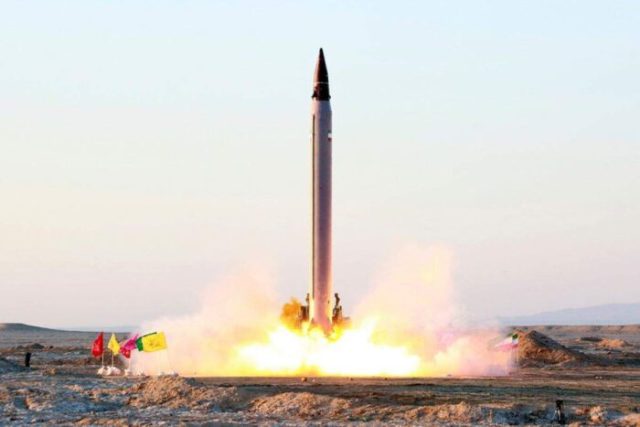
Iran's Imad ballistic missile The same applies to the video released in January 2021 after Iran's military exercises "The Great Prophet 15", which included live firing of the Imad BR.
At that time, the commander of the AKC IRGC A. Hajizade said that his missiles successfully hit a model of a naval target in the Indian Ocean at a distance of about 1800 km. But the footage did not clearly demonstrate whether the simulated target in the ocean was actually hit.
As you know, the principles, methods and subsystems necessary for effective maneuvering during re–entry into the atmosphere – as for the Imad-like missiles - are very different from those used on shorter-range missiles. Taking into account also the time spent by other countries on the development of high-precision BRS with a range of more than 1000 km, IISS analysts believe it is unlikely that Iran will be able to deploy a high-precision BRSD earlier than 2024, although extensive foreign assistance from China or Russia may shorten the time by two to three years.
"Khorramshahr" (Khorramshahr)
"Khorramshahr" is a liquid–fueled single-stage BRSD, with a high probability borrowed from the North Korean Musudan missile (Musudan). The latter, in turn, is based on the Soviet ballistic missile R-27 (SS-N-6 Serb), installed on submarines. It is reported that Tehran acquired 18 such missiles directly from Pyongyang, approximately in 2005.
For the first time "Khorramshahr" was presented during a military parade on September 22, 2017. The rocket has a length of about 13.5 m and a diameter of 1.5 m. The 4D10 engine installed on it from A.M. Isaev Kbkhimmash JSC differs from the Shekhab variants and was originally developed for the Soviet R-27 rocket. It uses a different, more efficient combination of fuel and oxidizer, consisting of asymmetric dimethylhydrazine (NDMG) and nitrogen tetraoxide. According to media reports, four Khorramshahr flight tests were conducted, of which at least one was a test of an upgraded version of the Khorramshahr-2.
During the first launch, which was reported on July 11, 2016, according to publications, the rocket exploded shortly after launch, repeating North Korea's unsuccessful attempts with the Musudan in the spring of the same year. It is reported that on January 29, 2017, during the phase of the flight without an engine, a catastrophic failure occurred about 900 km from the launch pad. The reasons for the failure of the rocket, after a significant period after the engine was stopped, and before it would re-enter the atmosphere, were not reported.
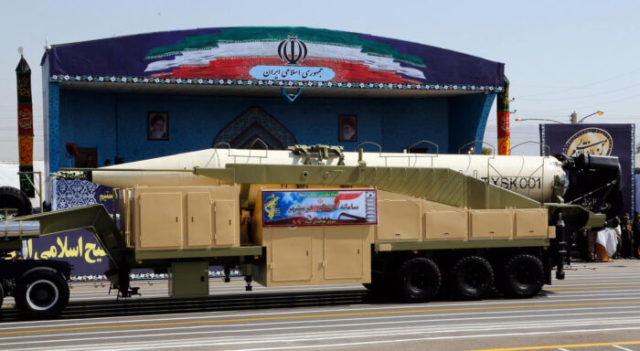
Khorramshahr Ballistic missile Footage of the third possible flight test was shown at the military and defense exhibition "Ektedar 40" (Eghtedar 40) in Tehran, in February 2019.
But compared to previous versions, the rocket in the video had a different, smaller warhead with a conical section connecting the nose compartment to the rest of the rocket body. The poster displayed a more detailed image of a missile marked "Khorramshahr-2", which had a warhead with ribbed stabilizers of the "Imad" type.
The footage of the potential fourth launch appeared in August 2020, when the Fars news agency reported on the successful test of the Khorramshahr-2 and the defeat of its warhead of the target site measuring 40 x 40 m. It is noted that in the video the missile had the same finned warhead as on the poster at the Ektedar 40 exhibition.
There is some debate about the range of the Khorramshahr. The commander of the AKC IRGC A. Hajizade said in 2017 that the missile is capable of delivering a payload weighing 1800 kg at a range of 2000 km. The above–mentioned poster from the exhibition also indicated a range of 2000 km, but a payload of 1500 kg. These data differ somewhat from the assessment of independent experts that the North Korean Musudan, which was most likely a prototype of the Khorramshahr, probably has a range of 2500 to 4000 km, although with a lighter warhead.
Assuming it is equipped with the same engine as the Musudan, the engineering reconstruction shows that the Khorramshahr, at least, has a range of 2000 km when carrying a payload of 1000 kg. If the mass of the warhead is reduced to 500 kg, the range may increase to 3000 km, although this is a very approximate estimate. In the end, a more accurate assessment is possible only if there is additional information or the results of flight tests.
One of the possible explanations for the very large (from 1500 to 1800 kg) payload declared for Khorramshahr, experts believe that the rocket is designed to install several warheads or false targets to saturate missile defense systems. Since Iran's regional opponents are investing heavily in missile defense, it seems economically advantageous for Tehran to try to overcome these systems with the help of missile volleys and false targets. A. Hajizadeh also pointed out in 2017 that the Khorramshahr is capable of carrying several warheads. However, foreign experts believe that this statement most likely refers to submunitions, and not to several independently controlled warheads with individual guidance of the MIRV type. The latter is a technically complex solution and requires flight tests, which, apparently, have not yet been conducted.
Despite reports by the Iranian media about the targeting of the warhead at the final site for both Khorramshahr-1 and -2, there is not enough public evidence to independently verify these claims. Since the guidance of the first variant of the Khorramshahr could rely on an older inertial navigation system similar to the one installed on the Musudan, the QUO missile is estimated at 1500 m. The presence of stabilizers on the Khorramshahr-2 warhead may improve this characteristic of the missile.
Although the early unsuccessful tests of the Khorramshahr left open the possibility of Tehran abandoning the system without completing its development, recent flight tests, as well as the appearance of a new upgraded version, show that work under the project will continue, at least in the near future.
Iran's ability to manufacture Khorramshahr in large quantities is limited by its ability to produce engine and fuel or purchase them from foreign suppliers. If Tehran gets access to enough engines, it will be able to design and build an arsenal of Khorramshahr missiles with lighter warheads capable of hitting most of southern and eastern Europe and possibly even France. In addition, if Iran decides to build a multi-stage intercontinental ballistic missile (ICBM) and is able to master the technology of 4D10 engines, it will also be able to use these engines as building blocks for such a system.
To be continued…
Based on the materials of the resources: iiss.org, missilethreat.csis.org, iranprimer.usip.org
